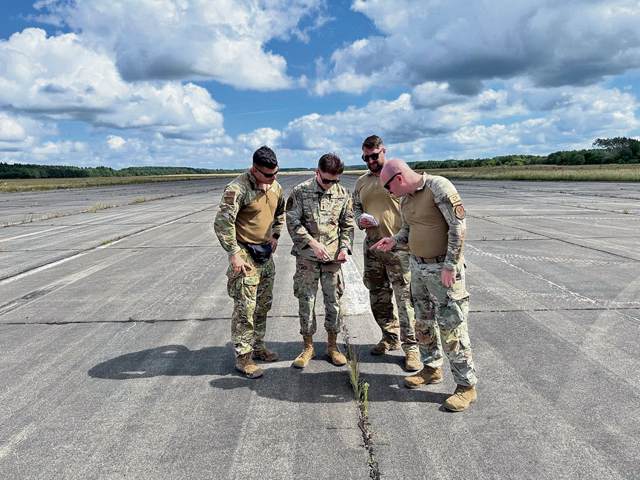
The U.S. Air Force has introduced a new tool designed to streamline the process of assessing and certifying airfields for aircraft landings, particularly in austere environments. Developed by members of the 435th Air Ground Operations Wing Innovation Team, the new mobile application enhances efficiency, reduces human error, and provides real-time data to support rapid decision-making in the field.
The Wing Innovation Team is an element of Project Arc, a larger Air Force initiative. Project Arc places military personnel and government civilians into operational wings across the globe. They collaborate with pilots, maintainers, logisticians, and other technical roles within the Department of the Air Force to implement cutting-edge technology, conduct experiments, prototype new solutions, and rapidly adapt to stay ahead of the technology used by U.S. adversaries.
U.S. Air Force Staff Sgt. Justin Salvione, an airborne air traffic controller with the 435th Contingency Response Squadron, and U.S. Air Force 1st Lt. Trevor Akers, a developmental engineer from the 96th Cyberspace Test Group currently supporting the 435th AGOW’s Innovation Program, spearheaded this effort.
The traditional method of assessing airfields involves a labor-intensive process that relies on pen-and-paper documentation, manual calculations and the coordination of multiple specialists. These assessments are critical for determining whether an airfield can safely accommodate specific aircraft, such as the C-130 Hercules or C-17 Globemaster III, especially in combat zones or remote locations.
“When we go out to survey a landing zone, we evaluate everything from the strength of the landing surface to the glide slope ratio, ensuring there’s enough clearance for an aircraft to land safely,” Salvione said. “Traditionally, this meant compiling data manually, which could take hours and leave room for human error.”
Enter Akers, who pursued the vision of Tech. Sgt. Benjamin Stewart, a contingency response airfield manager with 435 CRS, who saw an an opportunity to streamline this process through digital innovation.
“The idea was to eliminate the manual calculations and paperwork, replacing them with a mobile application that could do everything on the spot,” Akers said. “This allows us to gather and process data two to three times faster than before.”
The mobile app allows airfield assessment teams to input data directly into their devices while in the field. This data includes measurements of surface conditions, potential obstacles and the strength of the airfield’s pavement or ground surface. The app then automatically calculates the viability of the airfield for different aircraft, providing an immediate green, yellow or red light for each criterion.
“The app not only saves time but also reduces the risk of human error,” Salvione said. “Instead of three people calculating different aspects of the assessment, the app centralizes everything, ensuring that all data is consistent and accurate.”
One of the most significant advantages of this digital approach is the ability to quickly generate and share reports.
“We can now download a comprehensive report with just a few clicks and share it with HHQ teams instantly,” Akers said. “This capability is crucial when time is of the essence, such as during agile combat employment scenarios.”
The new tool is particularly valuable for the DAF’s Agile Combat Employment strategy, which emphasizes flexibility and speed in deploying forces to austere environments. The 435th CRS’s Airborne Assessment Team — the only one of its kind in the Air Force — often deploys to assess potential landing zones before the arrival of ‘open-the-base forces.’
“Our team can parachute into a location, assess the land, and relay our findings back to leadership with a four-hour cap,” Salvione said. “With this app, we can expedite the process even further, allowing for quicker decision making on whether or not to bring in U.S. or partner nations forces or aircraft.”
Akers also highlighted future applications of the app such as calculating the glide slope ratio, which determines if there is enough clearance for an aircraft to land.
“We’re actively working on adding this functionality, along with a calculator for determining the size of drop zones based on the type and quantity of equipment or personnel being deployed.”
While the app already offers improvements over traditional methods, the development team sees potential for even more enhancements.
“We’re constantly coming up with new ideas,” Akers said. “For example, we’re looking into integrating a feature that would allow users to input specific mission parameters — such as the number of personnel and equipment to be dropped — so that the app can automatically calculate the required size of a drop zone.”
Akers said that the development has been a team effort, with input and feedback from a wide range of Airmen, engineers and commanders.
“We’ve only been working on this for a short time, but the progress we’ve made is incredible,” Akers said. “We’re excited to see where it goes next and how it can further support the Air Force’s mission.”
As the app continues to grow in functionality, it could become a valuable tool for airfield assessments and beyond. Whether in peacetime or deployment, the ability to accurately assess landing zones could make a significant difference in the success of future missions.


